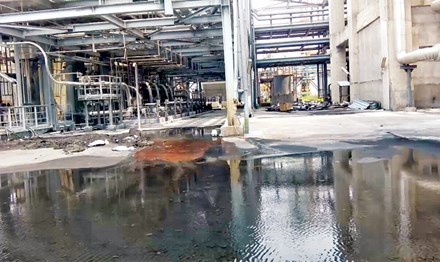Ninh Binh fertiliser plant permanently suspends operation
 |
The plant’s construction was kicked off in May 2008 in Ninh Binh’s Khanh Phu industrial zone and came into operation in 2012, after 42 months of construction.
In the nearly four years since then, the plant has been continuously operating at a deficit, accumulating altogether over VND2 trillion ($89.9 million) in losses. Notably, in 2012, the company’s losses amounted to VND75 billion ($3.37 million), which increased to VND759 billion ($34.12 million) in 2013, VND500 billion ($22.48 million) in 2014, and VND370 billion ($16.63 million) in 2015.
The plant was forced to call a temporary halt to its operations in late March, however, Vinachem has decided against opening the plant’s gates again. The company has temporarily laid off 400 of its 1,100 workers, paying the monthly unemployment allowance of VND3.1 million ($139.37) each worker.
According to Nguyen Gia The, deputy general director of Ninh Binh nitrogenous fertiliser plant, the company has difficulties maintaining operations because the already high production expenditures are increasing even further, while fertiliser prices are in a continuous plunge on the domestic market. At present, the plant is storing approximately 50,000 tonnes of unsold fertiliser.
Exacerbating the company’s difficulties, the plant was equipped with low-quality Chinese machinery, leading to high maintenance expenses that contributed to the suspending of operations.
Along with its losing operation, the plant also caused serious environmental damage by discharging untreated wastewater into the Day River, only three months after it started operations. During an unannounced inspection in October 2012, the Police Department for Environmental Crime Prevention and Control (C49) detected that the plant discharged a wastewater volume of 5,000 cubic metres per hour, causing a massive wave of death in fish stock and cattle in the nearby region.
With an annual output of 560,000 tonnes, the plant was expected to meet 25 per cent of the country's demand for urea fertiliser, helping the nation save $250 million on imports.
Together with the fertiliser plants in Phu My, Ca Mau, and Ha Bac, the plant was to meet the country's demand for urea nitrogenous fertilisers and help stabilise Vietnamese fertiliser production, and contribute to national food security.
What the stars mean:
★ Poor ★ ★ Promising ★★★ Good ★★★★ Very good ★★★★★ Exceptional
Latest News
More News
- Hanoi symposium highlights gender equality research and policy (December 03, 2025 | 12:00)
- Germany and Vietnam discuss development cooperation (December 02, 2025 | 20:39)
- Vietnam to limit raw rare earth exports (December 02, 2025 | 17:08)
- Japanese embassy marks 20 years of Japan-ASEAN bond market support (December 02, 2025 | 16:57)
- Roadmap unveiled to tighten vehicle emission standards (November 29, 2025 | 09:00)
- Technology and green finance emerge as twin pillars for Vietnam’s sustainable growth (November 28, 2025 | 10:52)
- Experts weigh in on Vietnam’s sustainability progress and future priorities (November 27, 2025 | 18:51)
- Green manufacturing insights and transformations: SABECO’s path to industry leadership (November 27, 2025 | 14:35)
- Siemens leads technology transformation towards sustainability in Vietnam (November 27, 2025 | 12:29)
- Hanoi workshop targets market access for women-owned firms (November 27, 2025 | 09:00)
















 Mobile Version
Mobile Version